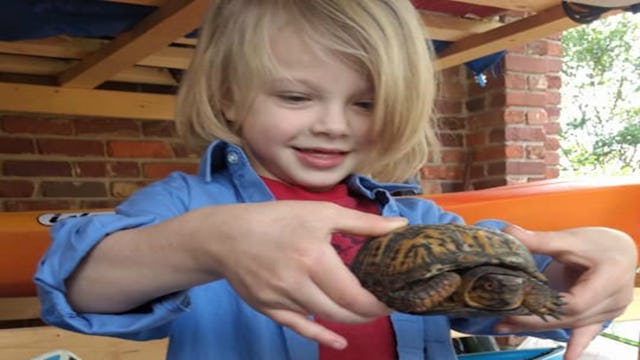Kids Need Nature, And That Includes Creepy-Crawlies Too

“It’s a snake!” Blaise shrieked with glee as he held the thrashing, dirt-caked creature between two hands.
“No, it’s a worm,” I said. I barely looked up from my laptop.
“No, it’s a worm snake!” he said happily. Because worm snakes, apparently, are a thing that exist, and exist in my yard, and my 7-year-old accidentally-on-purpose dug one up to study.
This is not unusual. If my kids are outside, my kids are trying to capture small creatures, generally of the reptilian variety. No Carolina anole is safe in my yard. In fact, the kids have spent so much time trying to catch them that we’ve named the ones in various territories: the giant blackish one on the trash can; his small, hissy challenger. There’s the striped skink that lives under the porch column and the giant brown skink that crawled from my nightmares to take up residence under some lumber. Some people might think this is savage. I actively encourage my kids, with the purchase of nets and visitor tanks, to gently engage with the wildlife.
Kids need nature. And part of needing nature is needing to handle the creepy-crawly, the slow-moving, the animate parts — in short, the most interesting stuff out there.
As Peter Kahn Jr. and Stephen Kellert say in their book Children and Nature: Psychological, Sociocultural, and Evolutionary Investigations, the natural world was the most important environment children encountered before they grew up. The scientists ask, and eventually prove, that animals “provide a means by which children come to care about nonsentient nature.” Basically, when kids play with animals, they deepen their connection to the natural world. And Richard Louv, author of Last Child in the Woods, says that kids’ “physical contact, their intimacy with nature, is fading.” So anything that we can do to cement that connection, to deepen it, to make it more vital, is a very good thing.
I don’t just let my kids catch animals. We also talk about them. Every night, they clamber to go on a toad hunt. My husband marches them into the yard where they hunt for toads and tree frogs. They carefully catch them and identify them. That’s how we learned that certain species of gray tree frog are genetically identical, but one has double chromosomes, so they’re actually distinct. We can tell a Southern toad from a Fowler’s toad on a good day. My kids know what the frogs and toads eat. They know that when it’s dry, the amphibians are likely holed up in their burrows, and the hunting will be slim.
They aren’t just catching nature. They’re learning about it. Some summer evenings will see them finding half a dozen toads. They might put a few in a plastic tank with water so they can watch them, draw them, make notes on their behavior. Then we release them.
We also take the controversial step — controversial! — of letting them tadpole. They have designated tadpole nets. We know the best places in town to find bullfrog spawn. I take them to the parks, ensconce myself under the tree with the dog, and let them go. They leap over rocks like billy goats. They get wet and muddy. They actually catch tadpoles, and they compare stages of development: “Mine has legs!” “Look how long mine’s tail is!” If the tadpoling’s bad, they catch minnows. And if they can’t find any of the above, they go after water striders.
The ultimate amphibian, the salamander, they usually only manage to catch in the mountains, though we improbably once found one deep in the hummus of our yard. All this helps give them respect for a health stream. It gets them in nature. It gives them a goal. They help each other; they share nets and tips and tadpoles. They work together, and they crawl home muddy and exhausted. It’s everything a mother could ask for.
They genuinely love creepy-crawlies. While roaches (ahem, palmetto bugs) gross them out, they adore spiders, especially big ones. They happily point out enormous millipedes during night walks by the river. I like to think that our encouraging them to catch toads and worms (not even worm snakes, just worms) has extended their love of nature to the traditionally unlovable. That seems to be the case, so far.
PETA’s going to kill me for this. They are going to argue that the animals have as much right as we do to live unmolested, and we’re infringing on their rights. Why can’t we watch them from a distance? Because it’s not the same. You need to feel the slime of a tadpole, the bumps of a toad, the minnow’s slick quicksilver, and the teensy-needle chomp of an anole. None of these animals are being mistreated, abused, or taken in as pets. My 3-year-old can handle a lizard without making it drop its tail. This is an important life skill.
I’ll say it again: Kids need nature. And they need nature at a level they can understand. They don’t get Thoreau’s pond. They aren’t going to wander awestruck through the cathedral of pine trees or admire the Zen-like tumble of rocks by the river. Instead, they see those rocks as a playground, those trees as something to climb, and whatever lives there — the toads, the frogs, the worm snakes and salamanders and tadpoles — as something to admire.
So, here’s to adventures, from toad hunts to worm-digging. Let the kids get dirty and explore.
Note: My son knows how to identify a worm snake, which looks exactly like a worm. Children should never attempt to approach, touch, or handle a snake of any kind in the absence of an adult trained in herpetological identification.